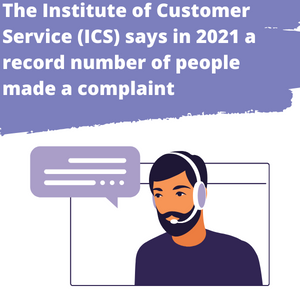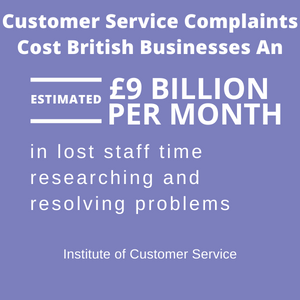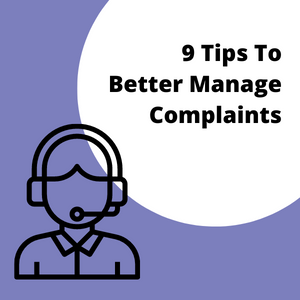 In the past “the customer is always right” was a mantra that informed good service across multiple sectors. Global talent shortages however have led to lesser qualified individuals and badly trained employees in customer-facing roles. This is compounded by ill-conceived online customer journeys and the increase of low-quality goods at a cheap price point. The status of the customer has thus diminished in the eyes of some brands. It’s a short-sighted view where some brands equate sales with success without considering the long-term implications of failing to manage customer service and complaints properly. We don’t in fact need to wait for incidents to arise to react; no one likes firefighting. If businesses invested some time and money into equipping their teams with the tools to deliver good customer service and adequate complaints-handling training, it is a strategy for sustained long-term growth.
In the past “the customer is always right” was a mantra that informed good service across multiple sectors. Global talent shortages however have led to lesser qualified individuals and badly trained employees in customer-facing roles. This is compounded by ill-conceived online customer journeys and the increase of low-quality goods at a cheap price point. The status of the customer has thus diminished in the eyes of some brands. It’s a short-sighted view where some brands equate sales with success without considering the long-term implications of failing to manage customer service and complaints properly. We don’t in fact need to wait for incidents to arise to react; no one likes firefighting. If businesses invested some time and money into equipping their teams with the tools to deliver good customer service and adequate complaints-handling training, it is a strategy for sustained long-term growth.
“A complaint is a chance to turn a customer into a lifelong friend.”
Sir Richard Branson
The benefit of exceptional complaint handling
In 2017 Virgin Money decided to see if their founder’s proclamation was in fact true. Their customer service team decided to set three specific goals:
- Reduce the overall number of complaints.
- To improve complaint-resolution time
- To reduce the number of complaints escalated to ombudsman services for resolution.
To the outsider and quite possibly internally, this seemed nothing short of idealistic. Their approach however resulted in a cultural transformation that yielded results and numbers that were frankly incredible. In every single area that they set out to improve, Virgin Money succeeded. By giving their staff focused training and the autonomy to deal with complaints as they saw fit, the customer service team achieved their goal. It was the additional benefits beyond their goals that no one could have predicted. Not only did customer retention and recruitment grow but so did their customer base. In the 12 months following the implementation of their strategy, they saw a 15% increase in their customer base taking it to 3.3 million
 Poor complaint handling
Poor complaint handling
In complete contrast to this approach is the budget airline Ryanair. When you type ‘complaints handling Ryanair’ into a search engine and one of the first results that show says “Is it worth complaining to Ryanair?” you already know that their take on complaint handling is vastly different to Virgin’s positive and proactive stance. In 2019 Which? carried out a survey of its 4000 members where the recipients of the survey were given a choice of 50 words to describe Ryanair. ‘Greedy’, ‘sneaky’ and ‘arrogant’ were the top choices, a frankly damning indictment of how consumers felt about the company. It was the 6th year in a row the airline had been voted the worst and they have shown no interest in reacting to the feedback, finishing once again in the bottom two in 2021.
Causes of poor complaint handling
Without a doubt, a lack of training in complaint handling leads to a worsening of the situation. It’s not just complaint handling and good customer service that must be trained, employees need strong product and system knowledge. A lack of training can lead to poor decision-making around product or service recommendations and inferior knowledge of the market will also exacerbate issues. An approach that looks at customer touchpoints and examines processes and systems will identify training needs and develop strategies to increase positive customer experience and reduce complaints. As Sir Richard said, it’s about switching our mindset and seeing a complaint as an opportunity.
So, what is the damage of not handling customer complaints effectively?
A complaint can be an indicator of potentially catastrophic issues within your business. To ignore them has real ramifications. Complaints erode customer trust and lead to loss of business and damage to brand reputation. A far more frightening statistic is that less than 5% complain, and the other 96% simply leave and start using a competitor.
The benefit of effectively handling complaints
When complaint handling is trained properly it increases positive brand equity and builds trust. With a vast array of online review forums where recommendations are used by other consumers to inform the likelihood of purchase, a well-thought-out strategy can mean that instead of complaints, there is in fact great potential to grow your business. A case in point is Virgin Money which following its targeted approach to complaints saw its Net Promotor score jump from +29 to +40.
 In the first instance, any company that has multiple opportunities for employee engagement will be ahead of the game in reducing complaints. The people at the coalface know exactly what causes issues day to day, where the bottlenecks are, and where the process fails. Either utilise employee survey tools to ask those questions or gather your team and let them discuss service difficulties. Prevention is better than cure and having a view of where the current issues are centred provides a starting point. Engage with those employees on the outcomes. Ask them for solid strategies that can prevent complaints. Curate a training program that focuses on world-class customer service then instigate a complaint handling policy which could include the following:
In the first instance, any company that has multiple opportunities for employee engagement will be ahead of the game in reducing complaints. The people at the coalface know exactly what causes issues day to day, where the bottlenecks are, and where the process fails. Either utilise employee survey tools to ask those questions or gather your team and let them discuss service difficulties. Prevention is better than cure and having a view of where the current issues are centred provides a starting point. Engage with those employees on the outcomes. Ask them for solid strategies that can prevent complaints. Curate a training program that focuses on world-class customer service then instigate a complaint handling policy which could include the following:
- Respond to the complaint within a reasonable time frame. 46% of people expect to receive a reply within 4 hours. Although this may not be feasible for many businesses, it is critical to provide customers with a time frame and stick to it. According to research where 500,000+ interactions were studied customers spend more with businesses that respond quickly.
- Avoid turning the complaint into a confrontation – ‘you were wrong, we were right’.
- Thank the customer for highlighting an issue and apologise.
- Make sure you always respond to the complaint as positive handling can go in your favour.
- Be proactive and provide frequent opportunities for consumer feedback.
- Treat your complaints as a learning opportunity to change the process or instigate training.
- Give your team the autonomy to decide on the best resolution. Consider setting an amount they can credit/discount without needing management approval.
- Be a solution focussed business rather than driven by what you can’t do.
- Ensure your training remains current and relevant as your market evolves.
Finally, always make sure there is a way to record the complaints and measure metrics that facilitate meaningful analysis of the data. With this data ask questions:
- Has this issue happened before?
- Is there a complaint pattern emerging either in type, department, or product?
Effective complaint handling can be achieved if there is a respectful, positive relationship and a strong rapport between provider and client. This can only be achieved at scale and on a consistent basis if the right conditions are cultivated by the organisation; building an internal culture for team members to do their job to the best of their ability, supported by training and coaching as well as a psychologically safe environment that facilitates communication and feedback. In any customer interaction, the relationship between provider and customer is paramount. Conflict can only be resolved if the employee clearly wants to help, and the customer is giving permission to do so.


